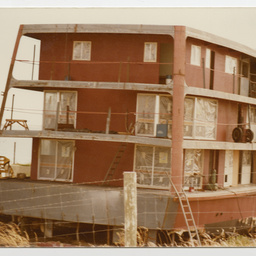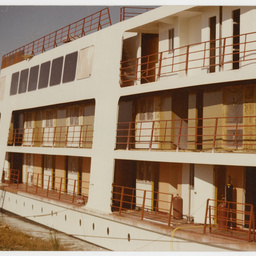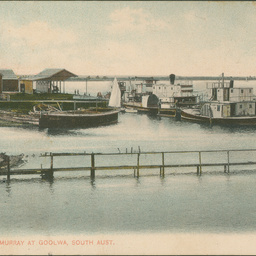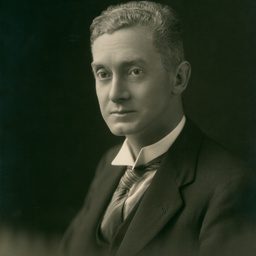Find • hindmarsh • Results 631 to 660 of 1,014


Paddlesteamer
View of the nearly complete hull of the Murray River Explorer - 16 May 1978.


Paddle Steamer
View of the front of the Murray River Explorer, 18 July 1978.


Paddlesteamer
View of the bow of the Murray River Explorer showing the cement bed. 6 January 1979.


Paddlesteamer
View of the front of the Murray River Explorer, 6 January 1979.


Paddlesteamer
Rear view of the Murray River Explorer, 6 January 1979.


Paddlesteamer
Side view of the Murray River Explorer, 6 January 1979.


Paddlesteamer
Side view of the Murray River Explorer while in the dock at water level, 11 February 1979.


Langhorne Creek
Timber sawing, with bullock power at Langhorne's Creek on the Potts property. Frank Potts arrived from England on the Buffalo with Governor Hindmarsh in 1836 and was thus one of the original settlers. In 1849 he built a ferry to cross the Murray at Wellington. He bought land and established the 'Traveller's Rest' to aid travellers enroute to the gold diggings. He built a bullock powered sawmill and cleared land for a vineyard. He named his property Bleasdale. Later he returned to boat building. He had previouslt built more than fifteen vessels. He was a well known local identity.


P.S. The Duke of Edinburgh at Goolwa
Murray River steamer 'The Duke of Edinburgh' at Goolwa with Hindmarsh Island visible in the distance. [Advice from A. Presgrave: This photo, B17414 and PRG 1258/1/840 are duplicate images. The date is probably ca.1868 as the Goolwa wharf is in the second stage of its development which included some extension to the jetty head in 1866.] The steamer in the photograph was identified by Captain John Grundy.


Goolwa wharf
Goolwa wharf in approximately 1904. The port was one of Australia's most important river ports, the wharf was built in 1852 and later extended and rebuilt several times. This photograph shows paddle steamers moored at the wharf and Hindmarsh Island in the background


Aerial view of Port Adelaide area
[General description] The North Arm of the Port River viewed from above with Lefevre Peninsula and the suburbs of Semaphore (middle of image) and Largs Bay (on right) in the distance, and the sea beyond. Both jetties can be clearly seen. The six masted ship on the river is probably a barquentine as its fore-mast is square-rigged and all others are fore-and-aft. [On back of photograph] 'Reproduced in the 'Chronicle', Feb. 5, 1927 / Aerial view of Port Adelaide River looking south west from the North Arm / 1927'. The following information was provided by a researcher: 'The Torpedo Station can be clearly seen in the middle of the photograph. It is the square piece of land on the corner of the North Arm and Hindmarsh Reach of the Port River. The creek that forms its eastern boundary (Perrys Creek) was extended and deepened by the Naval Reserve and Torpedo Station staff and used for mooring and storage of Naval vessels. The magazine and boat sheds can be seen. They ran along a raised road from the River to the point where Perrys Creek met the diagonal track into the Port. The track was rarely above water and was unpassable. The False Arm, near the Torpedo Station's southern edge, is also very clear'.


Captain Sturt's House, Grange
A watercolour by Nora Hutchinson of the rear of Captain Sturt's house at Grange. Sheds and chickens feature in the foreground. This is one of four paintings done of the house in May 1953 (B 12895 - B 12898). Nora Hutchinson 1908-1972 was born into a wealthy aristocratic settlers family. She was an intelligent independent woman, a heritage conservationist who remained unmarried


Wool scouring plant
W. Peacock & Son's wool scouring plant on the Torrens at HIndmarsh. See S.A. Register, May 21, 1870, Supp., P. 8B.


St. John Ambulance station
Old St. John Ambulance Station, Unley.


Victor Harbor
[General description] View of Encounter Bay with the estuary of the Hindmarsh River in the foreground. There are town buildings along the shoreline and the Bluff can be seen in the distance. [On back of photograph] 'Victor Harbour / 1928'.


Victor Harbor
Aerial view of Victor Harbor showing the causeway across to Granite Island and the estuary of the River Hindmarsh.


Police Station, Victor Harbor
Police Station, Police Point, Victor Harbor. Note on the back of the photograph state "The part on the right said to have been built 1838-40. Demolished (whole building) in 1912. In use as a police station at the time. Putting green was on the site in 1932". Police Point was the point of land leading to the Causeway at Victor Harbour on which stood the Police Station from 1840. It was eventually demolished in 1912. In 1863 the Alexandra Bridge and the Hindmarsh Bridge over the Inman River were opened thus giving easier access to Police Point and aiding settlement.


Hindmarsh River railway bridge
Train travelling over bridge at Victor Harbor. According to a researcher, the bridge is highly regarded by the Institute of Engineers as it was designed and constructed by Monash's South Australian Reinforced Concrete Co and is still serviceable over one hundred years later.


Victor Harbor
View of Victor Harbor from Hindmarsh River.


Victor Harbor
View of Victor Harbor showing the estuary of Hindmarsh River, railway line & bridge.


Boating at Victor Harbor
Two groups boating on the Hindmarsh River, Victor Harbor.


Car Accident, Woodville
Accident between a car and horse cart on Port Road, Woodville.


Council Chambers Yankalilla
Looking towards Council Chambers at Yankalilla. The District Council of Yankalilla was constituted on 5th April 1854. Governor Hindmarsh recorded the Abororiginal pronounciation of Yoongalilla as applied to the District and noted this in dispatches of 1837.


Pastor Jacob Abbott
[On front of photograph] 'Born 1813 / Came out John Renwick 1836 / Pastor Abbott / Dec. 5, 1813' [General description] 'Head and shoulders portrait of Pastor Jacob Abbott who wears a beard with long mutton chop whiskers joining under the chin, with no moustache. With his wife and three children he arrived at Holdfast Bay in the ship John Renwick on February 10th,1837, a few weeks after the landing of Governor Hindmarsh from the Buffalo. A well loved and respected man he had a long career as a preacher, first with the Methodists, later the Christion Churches, travelling all around Adelaide and country regions. He was associated with many religious and philanthropic institutions including the Y.M.C.A., and the Royal Institute for the Blind.


Adolph Bartels
Adolph Bartels, Mayor of Adelaide. Mr. Bartels was born in Hanover, Germany. In his early years he followed the trade of cigar maker in Hamburg, later moving to Breslau. Here he met Mr. Seppelt, and in 1848 came out to Australia under contract, working at Seppeltsfield for a year. He then went to work for Messrs. Gerke and Rodemann as a cigar maker in Adelaide, and after a trip to the Victorian goldfields, he set up his own tobacconists shop. In 1865 he entered into partnership with G.H.C. Meyer as general agents and grain merchants. In 1866 Bartels was elected as representative of Hindmarsh ward on the City Council, a position he held for four years. In 1871 he was elected Mayor and held this position until 1873.


Adolph Bartels
Adolph Heinrich Friedrich Bartels was born in Hanover. After meeting Mr Seppelt in Brelau Germany he emigrated to South Australia under contract. He was a cigar maker, worked in the Victorian goldfieldds, was a general agent and grain merchant, representative for Hindmarsh ward, and Mayor of Adelaide from 1871 - 1873. He was married three times and had ten children


S. G. Blackman, Sheriff
Stanley George Blackman, Sheriff of South Australia; Marshall in Admiralty; Returning Officer (Adelaide District); Deputy Marshall of the High Court of Australia. Born at Hindmarsh January 23, 1886. Eldest son of GH Blackman. Educated at public school, Agricultural School and Pulteney Street School. Entered Sheriff's Office in 1903. Active service in Belgium and France in the Australian Imperial Forces. Sheriff October 1928. Married Ada, 2nd daughter of Herbert Tolhurst.


Robert William Botting
Robert William Botting, a carpenter from London (1818-1890). With his brothers Fred and Frank he established a carpentry and joinery business in Adelaide. They helped construct many buildings including the Bank of Australasia. During the Depression he opened a butchery business. He also worked at the Bendigo Gold Fields and farmed on Hindmarsh Island. He moved his family to New Zealand where he opened a successful butchery business and also mined gold. He died in New Zealand in 1890.


Chittleborough siblings
William Chittleborough of Reynella (left) and James Chittleborough of Hindmarsh with their sisters Mrs Sarah Ann Brown of Victoria (left) and Mrs Elizabeth Loney Bold of Reynella. The brothers and sisters from the Chittleborough family arrived from England with their parents, Maria nee Coats and James on board H.M.S Buffalo, on 28 December 1836. James (senior) died in 1854.


George Witherage Cotton
George Witherage Cotton 1821-1892 was a carpenter at Willunga, shop owner on Hindmarsh Island, land agent, land reformer, Member of the Upper House (which he entered aged 61), Methodist lay preacher. As a land agent he bought land for Prince Alfred College and was secretary of the school in it's first 20 years. His pamphlet 'Small Holdings, the Mainstay of Individuals and Nations' published in Adelaide in 1888 shows his views on working men's blocks schemes. Another entitled 'The Obligations of a Civil Government' shows his belief in putting people on the land thus providing a comfortable life for them.
